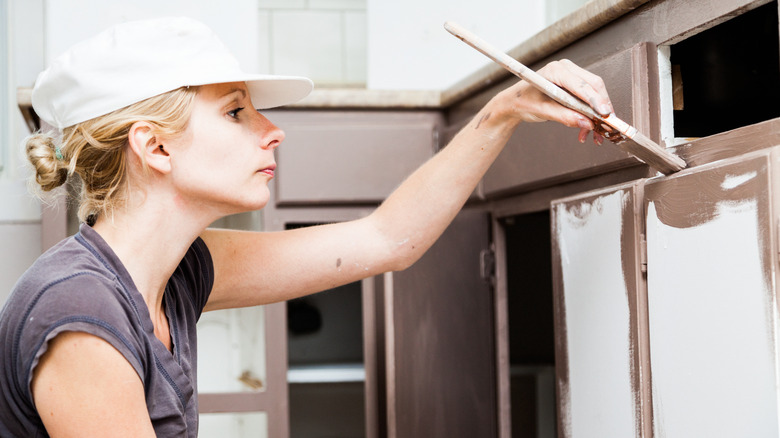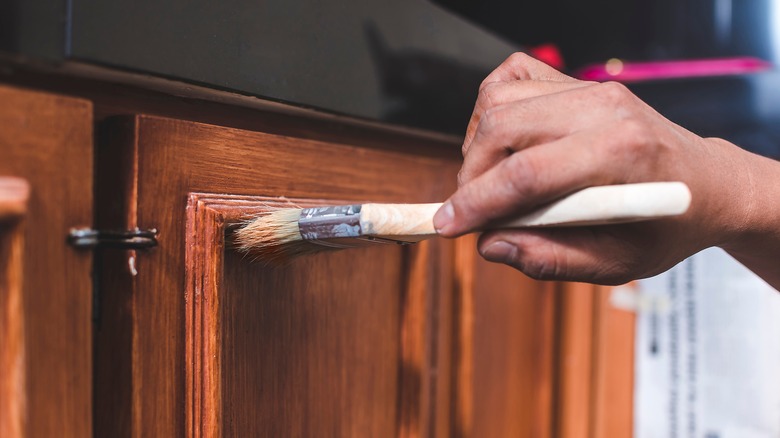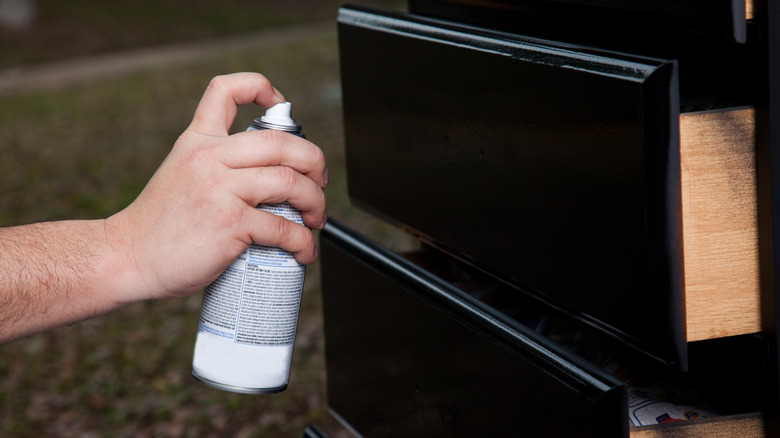The Easiest Way To Paint Your Kitchen Cabinets, According To An Expert
If you're looking to make a little update to your kitchen that won't break the bank, it might be a good idea to give those cabinets a fresh coat of paint. Over time, the heat and moisture in your cooking area could wear down the paint job and cause it to chip or look faded. That's when it can be the perfect time to revitalize your old kitchen cabinetry. Before you begin a project like this, you need to take a close look at your cabinets. If the wood has begun to warp, or there has been any water damage compromising the overall structure, then you may want to consider replacing everything with new storage.
On the other hand, if the bones of your cabinetry are still sturdy and you just want to update the aesthetic, a new paint job is an inexpensive DIY project you can accomplish in a matter of days. Although it may seem like a simple task, there will be plenty of edges, nooks, and crannies to work around depending on how detailed your cabinets are. This is where a little guidance from a professional goes a long way to getting the job done right. In an exclusive interview with House Digest, professional painter and blogger for Go Colorize, Jan Walter, gives us his expert advice on the easiest way to paint your kitchen cabinets. Let's see what he has to say.
Painting the exterior
Before you start the job of repainting your kitchen cabinets, you should first inspect their surfaces to see if there are any chips and scrapes that need attention. These can often be treated by giving the area a light sanding with a fine grain of sandpaper. However, professional painter Jan Walter suggests that deep gauges or cracks could require you to use a little bit of wood filler or spackle to seal off the imperfections and ensure that you have a smooth workable surface.
If you're not going through the process of stripping off the existing paint and you just want to cover what's already there, it helps to know what you're working with. "If [the cabinets have] been painted with a latex paint before and they're in good condition, then all you have to do is clean them thoroughly and then paint them with a high-quality latex enamel paint with the roller and paintbrush," says Walter. However, if the existing paint is oil-based, Walter urges you to "prime [the cabinets] for the top coat to adhere properly." For the best results on your cabinet exterior, he also advises that you "use a high-quality paintbrush with synthetic bristles, and a 4-inch paint roller with a foam cover or shed-resistant synthetic roller cover with a 5/16-inch nap for a nice finish."
Painting the interior
Painting the inside of your kitchen cabinets requires a little more finesse. "If you also want to paint the interior of the cabinets and your doors/drawers have intricate details, then it would be easier to spray paint them," expert Jan Walter advises. "If you don't have any experience with spray paint, you might get too much paint build-up in some places which would cause the paint to run or drip." Before you attempt to spray paint your kitchen cabinets, it's crucial that you cover any nearby surfaces, per Make It Right. Because spray paint is released through an aerosol can or sprayer, the tiny paint particles move through the air and could land on your floors, appliances, or kitchen counters. To prevent the mess from reaching these areas, tape down a drop sheet.
"If you're inexperienced then you can use a paintbrush and roller, but it will take longer and it's a lot more work," Walter mentions. For painting in a tight space, it's best to work slowly and make certain not to put too much paint on your brush or roller to avoid drips and streaks. Walter also suggests that, to save a bit of time, "It's easiest to not remove the doors and drawers from the cabinets, as it's easier to paint them in place. Only remove them if it's absolutely necessary."


